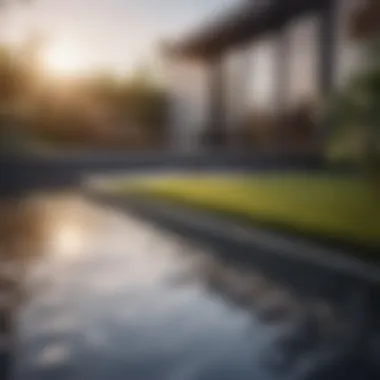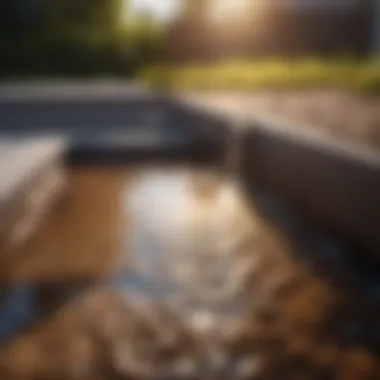Materials:
- Perforated Drain Pipe: 100 feet
- Drainage Fabric: 200 square feet
- Gravel: 5 cubic yards
- PVC Piping: 20 feet
- Catch Basins: 3 units
- Elbows and Connectors: 10 units
DIY Steps:
- Plan out the drainage system layout, marking areas for digging.
- Excavate trenches to the required depth and length following the planned layout.
- Line trenches with drainage fabric to prevent clogging.
- Place the perforated drain pipe in the trenches and cover with gravel uniformly.
- Connect the drain pipe to catch basins and other components using elbows and connectors.
- Test the system by pouring water into the drain to ensure proper flow.
- Backfill the trenches with soil and cover the surface appropriately.
Technical Aspects:
- Essential Tools: Shovel, Tape Measure, Level, Saw
- Timing: 2-3 days depending on yard size and complexity
- Critical Techniques: Slope trench for optimal drainage, compact gravel efficiently
DIY Project Process:
- Start by mapping out the drainage system layout accurately.
- Dig trenches according to the plan, ensuring proper depth and alignment.
- Install drainage fabric in trenches before laying the drain pipe and covering with gravel.
- Secure connections between pipe sections and necessary components like catch basins.
- Conduct a water test to check the efficiency of the system and make adjustments if needed.
- Finally, backfill the trenches with soil, leaving the yard looking neat and functional.
Troubleshooting Tips:


- If water pools in certain areas, check for blockages in the drain pipe or insufficient slope.
- Ensure all connections are tightly sealed to prevent leaks and inefficiencies.
- Consider redirecting downspouts and gutters to improve overall drainage.
Importance of Yard Drainage


Yard drainage plays a crucial role in maintaining the overall health and aesthetics of your outdoor space. Ensuring proper drainage helps prevent issues such as water pooling, soil erosion, and damage to your landscaping and property structures. By addressing drainage concerns early on, homeowners can avoid costly repairs and potential hazards.
Effective yard drainage also helps to protect the foundation of your home by directing water away from the property. Poor drainage can lead to water seepage into basements or crawl spaces, causing structural damage and mold growth. By understanding the significance of yard drainage, homeowners can safeguard their investment and create a healthier living environment for their families.
When planning yard drainage projects, it's essential to consider factors such as soil composition, natural slope, and climate conditions. Proper drainage solutions can enhance the curb appeal of your property, increase its market value, and provide a functional outdoor space for recreational activities and gatherings. Investing in yard drainage is not just about addressing immediate issues but also about preserving the longevity and sustainability of your home and its surroundings.
Factors Affecting Yard Drainage Cost


Understanding the factors that impact yard drainage cost is crucial in planning and executing drainage projects effectively. By delving into these factors, homeowners can make informed decisions that align with their needs and budget. Factors such as yard size, terrain, the type of drainage system, and the extent of water damage play a significant role in determining the overall cost of a drainage project. Considerations like the size of the area to be drained, the complexity of the landscape, and the severity of water issues all contribute to the expenses involved. By understanding these factors, homeowners can tailor their drainage solutions to suit their specific requirements, ensuring efficient water management while optimizing costs.
Yard Size and Terrain
The size and terrain of a yard are fundamental considerations when assessing drainage cost. Larger yards with varied topography may require extensive drainage systems to channel and manage excess water effectively. Steep slopes, low-lying areas, and compacted soil can pose challenges in proper water drainage, necessitating specialized solutions that may incur extra costs. Factors such as soil composition, vegetation cover, and proximity to water sources also influence the complexity and cost of drainage installations. By evaluating the unique characteristics of the yard, homeowners can determine the most suitable drainage approach that balances performance with affordability.
Type of Drainage System
Choosing the right drainage system is a pivotal factor in determining project cost. Various options, including French drains, surface drains, and sump pumps, offer distinct benefits and costs associated with their installation and maintenance. Factors such as soil permeability, water volume, and site accessibility impact the selection of the appropriate drainage system. Each system has its own requirements and installation techniques, influencing the overall project cost. By evaluating the specifics of the yard and water issues, homeowners can select a drainage system that meets their needs efficiently while considering the financial implications.
Extent of Water Damage
The extent of water damage in a yard directly influences the complexity and cost of drainage solutions. Chronic water issues causing erosion, flooding, or structural damage may require advanced drainage measures to mitigate further damage and restore the landscape. Assessing the severity of water damage involves inspecting the signs of water accumulation, mold growth, and soil saturation to identify the root causes of drainage problems. Addressing these issues comprehensively may involve additional costs for repairing existing damage, reinforcing drainage structures, or implementing more robust solutions. By understanding the extent of water damage, homeowners can prioritize effective drainage strategies that safeguard their property and investment in the long term.
Types of Drainage Systems
Understanding the types of drainage systems is crucial when considering yard drainage projects. Different systems offer unique benefits and considerations that can significantly impact the effectiveness and cost of the project. By delving into the various types of drainage systems available, homeowners can make informed decisions tailored to their specific needs.
French Drains
French drains are a popular choice for managing excess water in yards. These systems involve a trench filled with gravel or rock that redirects water away from the property. French drains are effective in preventing waterlogging and can be customized based on the yard's size and terrain. Homeowners should consider factors such as soil composition and slope when planning for French drain installations. Proper maintenance is essential to ensure the longevity and efficiency of French drains.
Surface Drains
Surface drains are designed to remove standing water from flat surfaces such as lawns and driveways. These drains feature grates or basins that collect water and direct it towards a suitable drainage outlet. Surface drains are advantageous in areas prone to flooding or water accumulation. Homeowners should evaluate the landscape and water flow patterns to determine the strategic placement of surface drains for optimal results. Regular cleaning and inspection are necessary to prevent clogs and maintain the functionality of surface drains.
Sump Pumps
Sump pumps are integral components of yard drainage systems, especially in areas with high water tables or frequent flooding. These pumps are installed in a sump basin and automatically channel excess water away from the property. Sump pumps are reliable solutions for managing groundwater and protecting basements from water damage. Homeowners should invest in quality sump pumps that match their property's drainage needs and consider backup power sources in case of outages. Routine testing and servicing of sump pumps are essential for ensuring their operational readiness during wet seasons.
Cost Breakdown of Yard Drainage Projects
The Cost Breakdown of Yard Drainage Projects is a crucial aspect to consider when planning any yard drainage project. Understanding the breakdown of costs involved can help homeowners make informed decisions and budget effectively. This section will delve into the specific elements, benefits, and key considerations related to the cost breakdown of yard drainage projects.
Materials
When it comes to yard drainage projects, the materials used play a significant role in determining the overall cost. High-quality materials are essential for the durability and effectiveness of the drainage system. From gravel and pipes to drainage fabric and connectors, each material serves a specific function in ensuring proper water management. Homeowners should invest in materials that are durable, weather-resistant, and suitable for their particular drainage needs. While initial costs may vary based on material quality and quantity, opting for superior materials can prevent future drainage issues and maintenance expenses.
Labor Costs
Labor costs are another key factor in the overall cost breakdown of yard drainage projects. Hiring professionals for installation ensures that the system is properly set up to function efficiently. The expertise and experience of laborers contribute to the successful implementation of the drainage system. Labor costs may vary depending on the complexity of the project, the number of workers required, and the duration of the installation process. While DIY approaches may seem cost-effective initially, incorrect installation can lead to more significant expenses in the long run. Investing in skilled labor ensures the proper construction and operation of the drainage system, resulting in long-term cost savings and peace of mind for homeowners.
Permits and Excavation
Obtaining permits and conducting excavation work are vital components of yard drainage projects that contribute to the overall cost breakdown. Before installation can commence, homeowners may need to acquire permits from local authorities to ensure compliance with regulations and standards. Permit costs vary depending on the project's scope and location. Additionally, excavation work is required to prepare the site for drainage system installation. Excavation costs include labor, machinery rental, and disposal of soil or debris. Proper excavation is essential for the effective functioning of the drainage system and prevents potential issues such as water pooling or blockages. By factoring in permit expenses and excavation costs into the overall budget, homeowners can ensure a smooth and successful yard drainage project.
Professional vs. DIY Installation
When considering yard drainage projects, one crucial decision housewives and house owners face is whether to opt for professional installation services or undertake a do-it-yourself (DIY) approach. This section delves into the nuances of both options to help readers make informed choices tailored to their specific needs and circumstances.
Professional Installation:
Choosing professional installation offers a range of advantages that can significantly impact the outcome and longevity of the drainage system. Professionals bring expertise honed through experience and training, ensuring that the installation is done correctly the first time. Their knowledge allows them to identify potential challenges, such as underground utility lines, that DIY enthusiasts might overlook, avoiding costly mistakes.
In addition to expertise, professional installers have access to specialized tools and equipment that are necessary for efficient and effective installation. By entrusting the project to professionals, housewives and house owners can rest assured that the work will be completed in a timely manner, with attention to detail that guarantees optimal functionality.
DIY Installation:
While professional installation offers many benefits, some house owners may opt for a DIY approach to save costs and enjoy the satisfaction of hands-on work. DIY projects can be fulfilling and provide a sense of accomplishment, especially for those with a penchant for landscaping and home improvement.
However, it is crucial to acknowledge the challenges associated with DIY installation. Without the expertise and resources available to professionals, DIYers may encounter issues during the installation process that could compromise the effectiveness of the drainage system. Lack of experience in grading, slope calculations, and proper drainage placement can lead to suboptimal results and potential flooding problems.
Considerations:
Before deciding between professional and DIY installation, housewives and house owners should carefully evaluate their skill level, available time, budget constraints, and the complexity of the drainage project. It is essential to weigh the cost savings of a DIY approach against the potential risks and drawbacks, such as improper installation leading to water damage or the need for costly repairs down the line.
Ultimately, the choice between professional and DIY installation rests on individual preferences and circumstances. By understanding the implications of each option, readers can make an informed decision that aligns with their goals and ensures the successful implementation of their yard drainage solutions.
Getting Quotes from Contractors
When embarking on a yard drainage project, one of the critical steps is obtaining quotes from contractors. This aspect holds paramount importance as it sets the groundwork for the entire project's financial outlook and quality. By seeking quotes from multiple contractors, homeowners can gain valuable insights into the estimated costs, scope of work, and expertise offered by each professional.
Specific Elements: Requesting quotes from contractors allows homeowners to compare pricing structures, services offered, and project timelines. It provides a clear overview of the financial investment required and helps in making informed decisions regarding budget allocations and project specifics. The details provided in the quotes enable homeowners to assess the quality of materials, labor costs, and any additional services included in the proposal.
Benefits: Engaging with multiple contractors for quotes ensures homeowners are presented with a variety of options, allowing them to select a contractor that best aligns with their budget, timeline, and expectations. This step empowers homeowners to negotiate favorable terms, clarify project details, and establish a transparent communication channel with the chosen contractor. Additionally, it fosters a competitive environment where contractors strive to offer competitive prices and high-quality services to secure the project.
Considerations about Getting Quotes from Contractors: When requesting quotes, homeowners should pay attention to the level of detail provided in the proposals, including breakdowns of material costs, labor fees, permit expenses, and any potential additional charges. It is essential to verify that the contractors are licensed, insured, and experienced in handling yard drainage projects to ensure the successful completion of the endeavor. Homeowners should also take note of the availability of warranties, post-installation services, and the reputation of the contractors within the local community as indicators of reliability and professionalism. Obtaining quotes from contractors serves as a pivotal stage in the yard drainage project planning process, granting homeowners the necessary information to make well-informed decisions and proceed confidently in transforming their outdoor spaces.
Tips to Lower Yard Drainage Costs
In the realm of yard drainage projects, finding ways to lower costs can be pivotal for homeowners to manage their budgets effectively. The significance of this topic lies in offering practical strategies to reduce expenses without compromising on the quality and effectiveness of the drainage solutions. By implementing the right tips to lower yard drainage costs, homeowners can ensure that their landscapes remain well-protected from water damage while staying within a reasonable financial scope.
One fundamental aspect to consider when aiming to reduce yard drainage costs is through regular maintenance practices. Regular maintenance plays a crucial role in preserving the longevity and efficiency of drainage systems. By inspecting and clearing any blockages, maintaining proper flow within the drainage channels, and ensuring that all components are functioning optimally, homeowners can prevent potential issues that may lead to costly repairs or replacements in the future.
Another essential strategy for minimizing yard drainage expenses is comparing multiple quotes from different contractors. This process involves obtaining detailed estimates from various professionals in the field, allowing homeowners to evaluate and compare the proposed costs, scope of work, and timelines. By having multiple quotes on hand, homeowners can make informed decisions based on a comprehensive understanding of the services offered, pricing structures, and overall value provided by each contractor. This comparative approach affords homeowners the opportunity to select the most cost-effective option that aligns with their specific needs and financial constraints.





